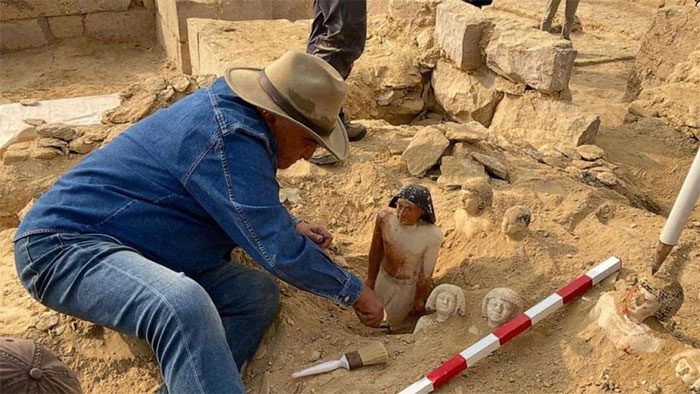On January 26, Egyptian archaeologists discovered several tombs of nobility from the 5th and 6th dynasties during the Old Kingdom period.
These new findings are located in an area known as “Gisr El-Mudir”, west of the famous pyramids at Saqqara – the Pyramid of King Djoser.

Ancient tombs discovered in the Saqqara necropolis, located about 30 kilometers south of Cairo. (Source: ABC News)
The most significant discovery is the tomb of Khnumdjedef, a supervisor of the nobility and a priest at the Unas pyramid complex, the last Pharaoh of the fifth dynasty (who reigned for approximately 15 to 30 years during the mid-24th century BCE).
The head of the Egyptian archaeological team, Dr. Zahi Hawass, stated that this tomb is decorated with images depicting the daily activities of ancient Egyptians.
The second largest tomb is believed to belong to Meri, the keeper of secrets and assistant to Pharaoh Unas. Additionally, a tomb of a priest was also discovered along with nine statues depicting a man with his wife and several attendants.
According to Dr. Hawass, a few months after the initial discoveries, the Egyptian archaeological team found a false door near the site where the statues were found.
This false door is inscribed with the name Messi, who may be the owner of the aforementioned nine statues.
Furthermore, archaeologists also found three other statues depicting a standing man, his wife holding one of his legs, and their daughter hugging a goose.
Dr. Hawass added that a 15-meter deep tunnel was discovered, along with a large rectangular limestone sarcophagus. The inscription on the sarcophagus reveals the name of its owner, Hekashepes.
Examination results show that this sarcophagus was completely sealed with plaster, similar to how ancient Egyptians preserved mummies 4,300 years ago. The mummy contained within is that of a man covered in gold leaves.
According to Dr. Hawass, this discovery may be the “oldest and most complete mummy found in Egypt to date”. Additionally, many stone vessels were found around the sarcophagus.


















































